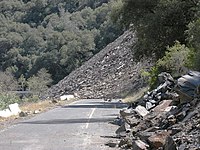
Photo from wikipedia
The main aim of this study is the description and the analysis of the monitoring strategies implemented within local landslide early warning systems (Lo-LEWS) operational all around the world. Relevant… Click to show full abstract
The main aim of this study is the description and the analysis of the monitoring strategies implemented within local landslide early warning systems (Lo-LEWS) operational all around the world. Relevant information on 29 Lo-LEWS have been retrieved from peer-reviewed articles published in scientific journals and proceedings of technical conferences, books, reports, and institutional web pages. The first part of the paper describes the characteristics of these early warning systems considering their different components. The main characteristics of each system are summarized using tables with the aim of providing easily accessible information for technicians, experts, and stakeholders involved in the design and operation of Lo-LEWSs. The second part of the paper describes the monitoring networks adopted within the considered systems. Monitoring strategies are classified in terms of monitored activities and methods detailing the parameters and instruments adopted. The latter are classified as a function of the type of landslide being monitored. The discussion focuses on issues relevant for early warning, including appropriateness of the measurements, redundancy of monitoring methods, data analysis, and performance. Moreover, a description of the most used monitoring parameters and instruments for issuing warnings is presented.
Journal Title: Landslides
Year Published: 2018
Link to full text (if available)
Share on Social Media: Sign Up to like & get
recommendations!